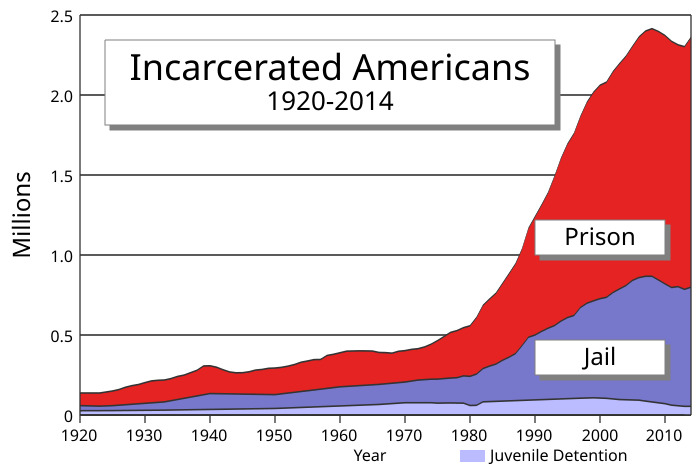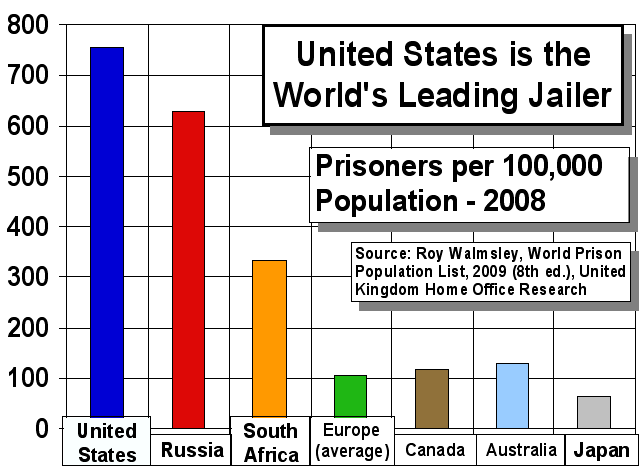
Leonard Pitts, Jr., writes in the Miami Herald:
"America is now the greatest jailer on Earth. Prison overcrowding is a growing problem; we literally cannot build facilities fast enough. As CBS News recently reported, the United States has less than 5 percent of the world’s population, but about 25 percent of its prisoners. As CNN recently reported, at 760 prisoners per 100,000 citizens, the United States jails its people at a rate seven to 10 times higher than most any other developed nation."As of 2006, there were 7.6 million people in prison or on probation or parole in the U.S. About 2.3 million were in prison, far more than the estimated 1.6 million in Chinese prisons. The actual rate of incarceration is far higher in the U.S. than in China, whose population is four times greater (see chart below, on which China doesn't appear).

Racial and ethnic disparities in sentencing have received considerable, and well-deserved, attention in recent years. According to the Sentencing Project, 60% of prisoners in U.S. jails are members of racial or ethnic minorities. SP also notes that, "of black males in their thirties, 1 in every 10 is in prison or jail on any given day" and "two-thirds of all persons in prison for drug offenses are people of color."
According to the 2010 census, the U.S. population is currently 63.3% white, so the minority/majority ratio is reversed in the prison population. Only 44.7% of prisoners on death row are white.
The stock response to this data goes something like this: "If minorities commit more crimes, they'll be overrepresented in the prisons." This facile argument neglects the many variables that affect the practices of police departments and courts -- from enforcement priorities (especially concerning drug offenses) to sentencing (as seen in the false distinction between powder and crack cocaine). [Example: A recent study showed that 89% of those stopped, questioned and frisked on the streets of New York were nonwhites.]
In an excellent special report on "Mass Incarceration in America" in The American Prospect, Michelle Alexander describes the obstacles facing members of racial and ethnic minorities upon their release from prison (which for 70% of offenders is followed by arrest and reincarceration within three years). These obstacles include such civil disabilities as inability to vote, enter public housing, apply for food stamps and obtain certain types of employment. Alexander notes: "We have not ended racial caste in America; we have merely redesigned it."
It's sadly predictable that the most effective media coverage of the prison-industrial complex and the solidifying U.S. caste system is provided by journalists of color like Leonard Pitts, Jr., and Michelle Alexander.
[Charts from Wikipedia]
__________________________________________________
*A tangential NOTE: Racial and ethnic disparities in prison populations seem destined to increase even further over time, as suggested by recent demographic changes in the U.S.: "Overall, racial and ethnic minorities accounted for 91.7% of the nation’s population growth over the past 10 years. The non-Hispanic white population has accounted for only the remaining 8.3% of the nation’s growth. Hispanics were responsible for 56% of the nation’s population growth over the past decade.
"There are now 50.5 million Latinos living in the U.S. according to the 2010 Census, up from 35.3 million in 2000, making Latinos the nation’s largest minority group and 16.3% of the total population. There are 196.8 million whites in the U.S. (accounting for 63.7% of the total population), 37.7 million blacks (12.2%) and 14.5 million Asians (4.7%). Six million non-Hispanics, or 1.9% of the U.S. population, checked more than one race."
[More on minorities driving U.S. population growth.]
